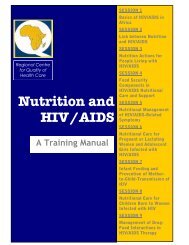Final Report - Linkages Project
Final Report - Linkages Project
Final Report - Linkages Project
You also want an ePaper? Increase the reach of your titles
YUMPU automatically turns print PDFs into web optimized ePapers that Google loves.
C.) Knowledge versus Practice (OD, PD and RAP samples combined)<br />
Knowledge vs. Practice - All <strong>Project</strong> Areas<br />
%<br />
100<br />
80<br />
60<br />
40<br />
20<br />
79<br />
70<br />
94<br />
75<br />
80<br />
47<br />
94<br />
57<br />
72<br />
80<br />
86 85<br />
70<br />
71<br />
49 52<br />
22<br />
88<br />
0<br />
TIBF EBF Eat more<br />
during preg<br />
Eat more<br />
during<br />
lactation<br />
Iodized salt Intro of CF Continued<br />
BF<br />
Feeding after<br />
illness<br />
Vitamin A<br />
frequency<br />
Correct Knowledge<br />
Correct Practice<br />
Conclusions:<br />
• Knowledge of key ENA behaviors is very high, between about 80% to 94% for all the ENA messages listed, apart<br />
from feeding of sick children after illness (only 49% knew the message) and frequency of vitamin A supplementation<br />
for children (52%). Practice for this latter ENA message was higher since the majority of children are reached<br />
through the twice-yearly mass campaigns.<br />
• The greatest discrepancy between knowledge and practice is the area of women’s nutrition, whereas most women<br />
knew they should eat more during pregnancy and lactation, only 47% and 57%, respectively, did so.<br />
44

















